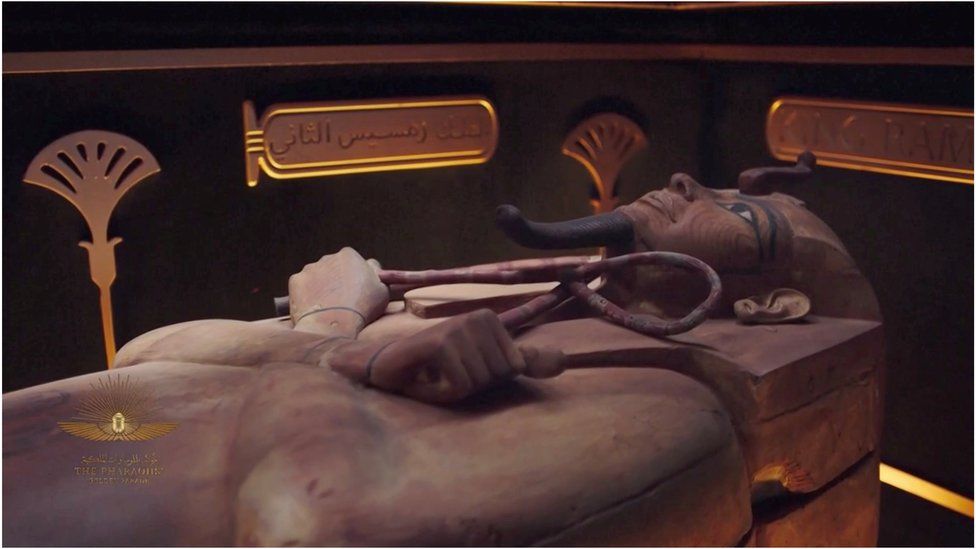The Pharaoh's Golden Parade, and the Lost Golden City.
Jumping straight into this blog post, it has been a wonderful week for Egyptian history!
The Pharaoh's Golden Parade
Firstly, On the 3rd April 2021, there was a live stream that was broadcast (I will attempt to attach the URL to the English live stream I watched below) which showed the movement of eighteen kings and four queens of Egypt from the Egyptian Museum in Tahrir to the National Museum of Egyptian Civilisation (NMEC). The spectacle saw music from the United Philharmonic Orchestra with traditional instruments as well as those that are more 'common', with short clips describing some of the historic sites of Egypt, and dancers in costume dancing at locations including:
* The Giza Pyramids Plateau
* The Grand Egyptian Museum
* Deir El Bahari Temple, Luxor
The 22 Kings and Queens were transported in chronological order to their new resting place, find King Ramesses II pictured below:

*To make this clear, this is NOT my image, I got it from here: https://www.bbc.co.uk/news/world-middle-east-56508475 *
The Kings and Queens were transported by bespoke vehicles, their purpose was to keep them safe from 'external conditions', to make sure they were protected at all cost. The event was attended by the president of Egypt, Abdel Fattah el-Sisi, who has been in office since June 2014 and has been classed as 'Ruler with an iron grip'.
The Kings and Queens included:
* Thutmose III
* Ramesses II
* Seqenenre
* Ahmose Nefertari
* Amenhotep I
* Thutmose I
* Thutmose II
* Hatshepsut
* Tiye
* Seti I
* Meritamen
* Amenhotep II
* Thutmose IV
* Amenhotep III
* Merenptah
* Seti II
* Siptah
* Ramesses III
* Ramesses IV
* Ramesses V
* Ramesses VI
* Ramesses IX
The transported Kings and Queens have been moved to the NMEC where they will be showcased, mimicking the 'Valley of the Kings' where their tombs were placed and discovered. The NMEC is now open, with the 'mummies Hall' opening on the 18th of April 2021. The museum itself commences with the Predynastic period, ending with the modern and Contemporary eras, find out more about the museum here: https://nmec.gov.eg/
I have attached some screenshots of the live stream that I took whilst watching it, they are my screenshots, however, I have attached the live stream itself and I recommend watching it as it is such an important and historical event. Watch the Pharaoh's Golden Parade here!
New and Exciting Discovery!
Excitingly, Renowned Egyptologist Zahi Hawass posted on his social media pages on the 5th April 2021 telling us to expect some news on a discovery that Hawass and his team have been working on, and that we were expected to know on the 8th April. This discovery was the excavation of a 'Golden' City not far from Luxor. The City has been named the 'Lost City of "Aten"' and according to a post by the Luxor Times, the city is c. 3,000 years old and dates back to the reign of Amenhotep III, and was used by Tutankhamun and Ay. The Luxor Times goes on to describe the city as 'the largest administrative and industrial settlement in the era of the Egyptian empire on the western bank of Luxor'. The area that the city is in, is between the temple of Ramesses III at Medinet Habu and the temple of Amenhotep III at Memnon.
According to the Luxor Times (I will try and attach the page, it is on Facebook: Luxor Times Source), the excavation started in September 2020 and it only took a matter of a few weeks to find formations of mud bricks, which then led to complete walls, and rooms 'filled with tools of daily life'. The city consisted of three royal palaces of King Amenhotep III as well as the Empire's administrative and industrial centre.
Salima Ikram, a renowned Egyptologist has also written about the discovery. She started that 'it has glorious sinusoidal walls, and looks as if people had just got up and left - a real Egyptian Pompeii' and 'it is the most important urban find since the discovery of Tell el Amarna!'. Salima Ikram Source
Lastly, Hawass's report on the discovery is of utmost importance, which stated that the city was 'the largest administrative and industrial settlement in the era of the Egyptian empire on the western bank of Luxor', along with a comment from Betsy Brian, a professor of Egyptology at John Hopkins University in Baltimore, stating that 'the discovery of this lost city is the second most important archaeological discovery since the tomb of Tutankhamun'. Dr. Zahi Hawass Source
The Washington Post has also reported on the discovery, you can find the article here: Washington Post Article. The article states that 'The lost city is the latest in a series of archeological discoveries unearthed in recent months across the country that are bringing fresh understanding of the dynasties that ruled ancient Egypt'.
Well, all I can say is that 2021 is turning into a great year for commemorating and discovering in Egypt, I hope this continues and I look forward to future discoveries from the 'Lost City'.











Comments
Post a Comment